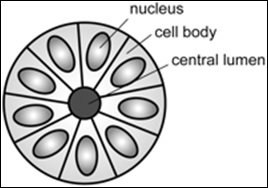Palisade (pathology)
Palisade (pathology)
In pathology, the term palisade refers to a specific histological pattern characterized by the arrangement of cells in a linear, fence-like formation. This pattern is often observed in certain types of tumors and other pathological conditions.
Histological Features[edit | edit source]
Palisading is typically seen in the context of basal cell carcinoma, a common type of skin cancer. In this condition, the tumor cells are arranged in parallel rows, resembling a palisade. This arrangement is thought to be due to the way the cells grow and interact with the surrounding stroma.
Clinical Significance[edit | edit source]
The presence of palisading can be an important diagnostic feature. For example, in basal cell carcinoma, the identification of palisading can help differentiate it from other types of skin cancer such as squamous cell carcinoma or melanoma. Palisading is also seen in other conditions such as schwannomas and certain types of gliomas.
Associated Conditions[edit | edit source]
Diagnosis[edit | edit source]
The diagnosis of conditions exhibiting palisading typically involves a combination of clinical examination, imaging studies, and histopathological analysis. A biopsy followed by microscopic examination is often required to confirm the presence of palisading and to determine the exact nature of the pathological condition.
Treatment[edit | edit source]
The treatment of conditions exhibiting palisading depends on the underlying cause. For example, basal cell carcinoma is often treated with surgical excision, radiation therapy, or topical medications. The specific treatment plan is determined based on the type, location, and extent of the disease.
Prognosis[edit | edit source]
The prognosis for conditions exhibiting palisading varies widely depending on the underlying pathology. For instance, basal cell carcinoma generally has an excellent prognosis with appropriate treatment, while the prognosis for gliomas can be more variable and depends on factors such as the tumor grade and location.
See Also[edit | edit source]
Navigation: Wellness - Encyclopedia - Health topics - Disease Index - Drugs - World Directory - Gray's Anatomy - Keto diet - Recipes
Search WikiMD
Ad.Tired of being Overweight? Try W8MD's physician weight loss program.
Semaglutide (Ozempic / Wegovy and Tirzepatide (Mounjaro / Zepbound) available.
Advertise on WikiMD
WikiMD is not a substitute for professional medical advice. See full disclaimer.
Credits:Most images are courtesy of Wikimedia commons, and templates Wikipedia, licensed under CC BY SA or similar.Contributors: Prab R. Tumpati, MD





